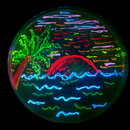Crush
Contributor
I found a reference on fluorescence (see here). It says, in part:
SCUBA divers rediscovered fluorescence in the 1950's. Luis Marden, a photographer for National Geographic magazine, wrote in 1956 that he noticed red anemones at a depth of 60 feet, where there should have been no red. The red color disappeared in flash photographs, and Marden correctly concluded that the effect was due to fluorescence.
So, according to the above, in order for what I saw to have been fluorescence, the red should have disappeared in the flash picture. Since it didn't, back to square one.
I keep agreeing with Matt S. Bioluminescence requires the organism to expend energy while fluorescence is passive, relying upon ambient light of a different wavelength. Unless the organism lived in an extremely low-light environment I believe that bioluminescence would be a waste of energy, especially if it would also not aid in procuring nourishment, procreation, or avoiding predation.
I disagree with Luis Marden's conclusion that the animal was not fluorescing because the red colour disappeared in flash photographs. Shining additional light on a fluorescent surface will never lessen the fluorescent light emission - his argument has no basis in science. Additional illuminating light may make the fluorescence less obvious by bringing out other colours, but the fluorescence will in no way be quenched. However, if you were to photograph this organism it might appear that the fluorescence magically vanished - the fluorescent light is still there, but so are many other colours, and since you had to close down your aperture to avoid over-exposure, it would appear that there is less fluorescent light. Try this experiment - shine a black light on a white T-shirt in the dark - it will fluoresce. Heck, mix yourself a gin & tonic - the quinine in the tonic water will also fluoresce in the dark in the presence of a black light. Now, black light in hand, go outside and repeat the experiment on a bright day. The fluorescence is still there, but you just can't see it because the reflected non-fluorescing light is now much brighter.
FWIW, fluorescent pigments absorb a range of wavelengths of light and re-emit that light at longer wavelengths over a range. The object might appear to you to have one red colour, but in fact it might be giving off light which ranges from orange to deep red.





